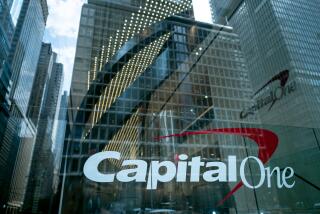J.P. Morgan, Chasing Citicorp, to Buy Bank One for $58 Billion
- Share via
J.P. Morgan Chase & Co. said Wednesday that it would buy Bank One Corp., creating a trillion-dollar bank in a deal that would further shift the U.S. financial industry’s power base to the Eastern Seaboard.
The combined institution would be a leader in investment banking, mutual funds, insurance and credit cards, and would cement J.P. Morgan Chase’s position as the No. 2 U.S. banking firm and one of three so-called super-tier banks, with Citigroup Inc. and Bank of America Corp.
Two decades of mergers in banking have led to gigantism: J.P. Morgan Chase-Bank One would have $1.1 trillion in assets. Citigroup has $1.2 trillion and Bank of America will have $933 billion after its merger with FleetBoston Financial.
Because of their financial resources, “these banks have enormous competitive advantages” over their smaller rivals, said Richard Bove, veteran industry analyst at Hoefer & Arnett Inc. in Pinellas Park, Fla.
That could have implications for San Francisco-based Wells Fargo & Co., which would rank as the fourth-largest U.S. bank though far below the top three. Wells, which has assets of $394 billion, could be compelled to seek a merger to boost its size, some analysts said.
New York-based J.P. Morgan Chase, with $793 billion in assets, has long been a premier name in consumer banking in the New York region and in corporate banking worldwide. It was formed by the 2000 merger of J.P. Morgan and Chase Manhattan.
Chicago-based Bank One, under 47-year-old Chief Executive James Dimon, has built itself into a huge player in consumer lending nationwide and the sixth-largest bank overall, with $290 billion in assets.
William B. Harrison, chief executive of J.P. Morgan Chase, said the two banks saw the merger as a chance to create “one of the world’s great financial services companies.”
The deal -- valued at $58 billion -- would mark Dimon’s return to New York five years after he was ousted from Citigroup in a power struggle with the latter’s chairman, Sanford I. Weill. Harrison, 60, would be chairman and CEO of the merged bank and Dimon would become president and chief operating officer -- and CEO in 2006, the banks said.
The merged headquarters would be in Manhattan.
“J.P. Morgan will be taking Citigroup on head-to-head,” said David Kungl, financial-institutions group director at SNL Financial in Charlottesville, Va.
The merger also would enhance the standing of the Eastern U.S. as home to the nation’s biggest banks. Bank of America moved its headquarters from San Francisco to Charlotte, N.C., in 1998 when it merged with NationsBank. Bank One’s departure from Chicago would leave the city without the headquarters of a top-25 U.S. bank.
A combined J.P. Morgan Chase-Bank One would have 2,300 branches nationwide, about 80% of them now belonging to Bank One. In California, the merged bank’s physical presence would be limited because Bank One has no branches in the state. But both banks serve California businesses and consumers with various products.
Under terms of the deal, J.P. Morgan Chase would pay 1.32 of its shares for each share of Bank One. J.P. Morgan Chase rose 32 cents to $39.22 on the New York Stock Exchange before the deal was announced. Bank One rose 61 cents to $45.22, also on the NYSE. The deal values Bank One at $51.77 a share.
More to Read
Inside the business of entertainment
The Wide Shot brings you news, analysis and insights on everything from streaming wars to production — and what it all means for the future.
You may occasionally receive promotional content from the Los Angeles Times.










